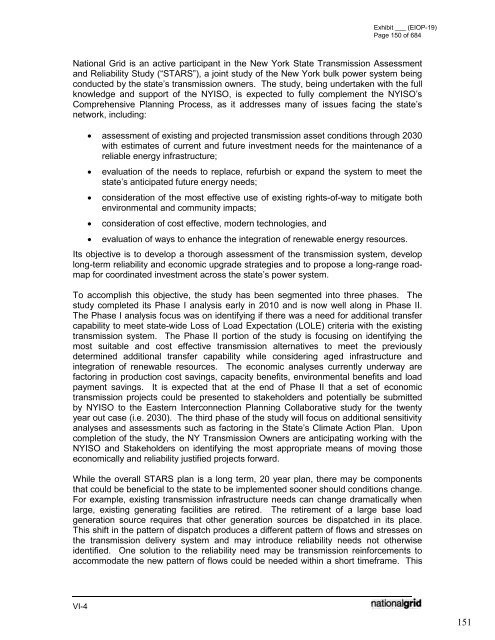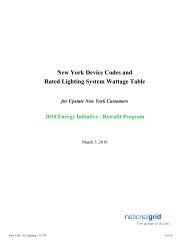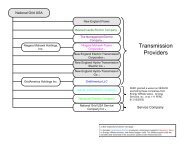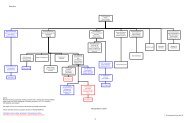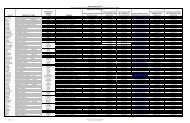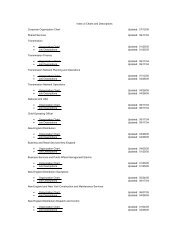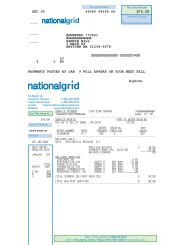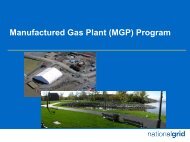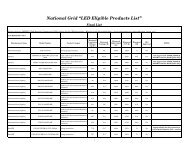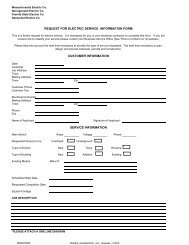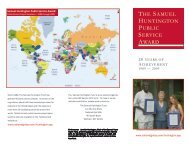January 2012 Capital Investment - National Grid
January 2012 Capital Investment - National Grid
January 2012 Capital Investment - National Grid
You also want an ePaper? Increase the reach of your titles
YUMPU automatically turns print PDFs into web optimized ePapers that Google loves.
Exhibit ___ (EIOP-19)Page 150 of 684<strong>National</strong> <strong>Grid</strong> is an active participant in the New York State Transmission Assessmentand Reliability Study (“STARS”), a joint study of the New York bulk power system beingconducted by the state’s transmission owners. The study, being undertaken with the fullknowledge and support of the NYISO, is expected to fully complement the NYISO’sComprehensive Planning Process, as it addresses many of issues facing the state’snetwork, including: assessment of existing and projected transmission asset conditions through 2030with estimates of current and future investment needs for the maintenance of areliable energy infrastructure;evaluation of the needs to replace, refurbish or expand the system to meet thestate’s anticipated future energy needs;consideration of the most effective use of existing rights-of-way to mitigate bothenvironmental and community impacts;consideration of cost effective, modern technologies, andevaluation of ways to enhance the integration of renewable energy resources.Its objective is to develop a thorough assessment of the transmission system, developlong-term reliability and economic upgrade strategies and to propose a long-range roadmapfor coordinated investment across the state’s power system.To accomplish this objective, the study has been segmented into three phases. Thestudy completed its Phase I analysis early in 2010 and is now well along in Phase II.The Phase I analysis focus was on identifying if there was a need for additional transfercapability to meet state-wide Loss of Load Expectation (LOLE) criteria with the existingtransmission system. The Phase II portion of the study is focusing on identifying themost suitable and cost effective transmission alternatives to meet the previouslydetermined additional transfer capability while considering aged infrastructure andintegration of renewable resources. The economic analyses currently underway arefactoring in production cost savings, capacity benefits, environmental benefits and loadpayment savings. It is expected that at the end of Phase II that a set of economictransmission projects could be presented to stakeholders and potentially be submittedby NYISO to the Eastern Interconnection Planning Collaborative study for the twentyyear out case (i.e. 2030). The third phase of the study will focus on additional sensitivityanalyses and assessments such as factoring in the State’s Climate Action Plan. Uponcompletion of the study, the NY Transmission Owners are anticipating working with theNYISO and Stakeholders on identifying the most appropriate means of moving thoseeconomically and reliability justified projects forward.While the overall STARS plan is a long term, 20 year plan, there may be componentsthat could be beneficial to the state to be implemented sooner should conditions change.For example, existing transmission infrastructure needs can change dramatically whenlarge, existing generating facilities are retired. The retirement of a large base loadgeneration source requires that other generation sources be dispatched in its place.This shift in the pattern of dispatch produces a different pattern of flows and stresses onthe transmission delivery system and may introduce reliability needs not otherwiseidentified. One solution to the reliability need may be transmission reinforcements toaccommodate the new pattern of flows could be needed within a short timeframe. ThisVI-44151


